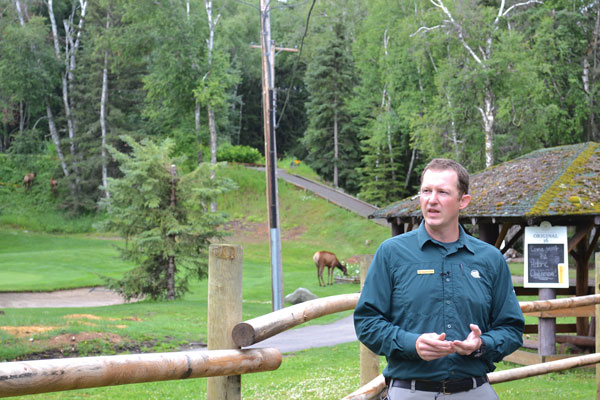
Parks Canada completes Waskesiu demonstration area showing how they prevent an uncontrolled blaze
A new demonstration area completed this April in Waskesiu is extinguishing a lack of preparedness for wildfires.
Parks Canada cleaned up the four-hectare area near the Water Treatment Plant under Saskatchewan’s FireSmart principles.
The effort was in collaboration with the Waskesiu Golf Course, which is in the demonstration spot. General Manager Tyler Baker said the course is continuing to work on preventing the rapid spread of wildfires.
“With the little scare we had last year with the Rabbit (Creek) fire and all the action that happened around getting all our buildings fire smart, you realize—there’s that sense that it could happen any minute.”
The wildfire in Prince Albert National Park’s Rabbit Creek spread over 36,665 hectares after it blazed over its control line in May of 2018.
In a media tour of the demonstration spot in Waskesiu on Wednesday, Parks Canada’s Dustin Guedo walked reporters through three zones.
Zone one is within 10 metres of the Water Treatment Plant. They cleared the area of materials that could ignite.
Zone two, which is between the 10 to 30 metre mark, is where they thinned out the evergreen trees and cleaned up dead, fallen over trees. However, Guedo said some were left as habitats for birds and other small animals.
In zone three, between the 30 to 100 metre area away from the building, they left space between the trees to limit the spreading of a potential fire and cleared flammable vegetation.
Guedo said having space between the trees facilitates growth by allowing more sunlight to reach new, smaller plants.
Glenn Rupert, Fire Management Officer for the park, said fires are actually important for maintaining the wild land.
“Where we can, we want fire on the landscape. It’s a natural process,” he said.
But, he explained, it’s especially important that they’re controlled in a community like Waskesiu —what he described as a transition space from an urban city to the wilderness.
“Reducing the risk of wildfire is a shared responsibility from property owners, to commercial operators, to government agencies like Parks Canada. We all have responsibility to help lessen the effects of wildfire. It’s important to take action now and not when the wildfires happen.”
Larry Fremont with Saskatchewan Wildfire Management spoke about what homeowners can do to prevent uncontrollable fires.
The Water Treatment Plant is a model for what you can do to your property, containing materials that are less likely to spread a fire.
“There are three things that determine how a fire will burn: The fuel, anything that will burn, including structures, the weather, obviously, and the topography,” he said. Topography is the arrangement of both natural and artificial features in an area.
“The only thing we can control is the fuels.”
Fremont pointed to the homes around the demonstration area, many of them having open space underneath. This is not uncommon, he said, saying to make sure you close off the area underneath your homes or the dry materials that build up can easily ignite.
He encouraged homeowners to use asphalt shingles on their roofs, which won’t carry a fire. Similarly, he said fibre cement siding won’t cause a new ignition, or it can take a lot of intensity before it does.
Waskesiu Community Council Chair Jim Kerby echoed many of his points as a cottage owner there. He also added it’s important to work with your neighbours to make sure the area is fire smart.
“We had a real wake up call in the spring of last year. The townsite was almost evacuated, and there was a real threat of wildfire causing significant damage,” he said, referencing the Rabbit Creek fire.
“People’s interests, I hope, have been heightened in recent times to say ‘I need to do something.’”
According to the Saskatchewan Ministry of Environment, people start 98 per cent of wildfires within three kilometres of communities.
Parks Canada also created the first Waskesiu fuel break—where coniferous trees and dead wood are removed—in 2001 and 2002 to prevent wildfires. They maintain it with controlled fires and thinning the trees.
In previous years, Parks Canada has allowed people to harvest their own Christmas trees as part of the fuel break maintenance.

